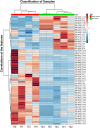Concurrent profiling of polar metabolites and lipids in human plasma using HILIC-FTMS
- PMID: 27819279
- PMCID: PMC5098236
- DOI: 10.1038/srep36490
Concurrent profiling of polar metabolites and lipids in human plasma using HILIC-FTMS
Abstract
Blood plasma is the most popularly used sample matrix for metabolite profiling studies, which aim to achieve global metabolite profiling and biomarker discovery. However, most of the current studies on plasma metabolite profiling focused on either the polar metabolites or lipids. In this study, a comprehensive analysis approach based on HILIC-FTMS was developed to concurrently examine polar metabolites and lipids. The HILIC-FTMS method was developed using mixed standards of polar metabolites and lipids, the separation efficiency of which is better in HILIC mode than in C5 and C18 reversed phase (RP) chromatography. This method exhibits good reproducibility in retention times (CVs < 3.43%) and high mass accuracy (<3.5 ppm). In addition, we found MeOH/ACN/Acetone (1:1:1, v/v/v) as extraction cocktail could achieve desirable gathering of demanded extracts from plasma samples. We further integrated the MeOH/ACN/Acetone extraction with the HILIC-FTMS method for metabolite profiling and smoking-related biomarker discovery in human plasma samples. Heavy smokers could be successfully distinguished from non smokers by univariate and multivariate statistical analysis of the profiling data, and 62 biomarkers for cigarette smoke were found. These results indicate that our concurrent analysis approach could be potentially used for clinical biomarker discovery, metabolite-based diagnosis, etc.
Figures





References
-
- Clarke C. J. & Haselden J. N. Metabolic profiling as a tool for understanding mechanisms of toxicity. Toxicol. Pathol. 36, 140–147 (2008). - PubMed
-
- Fernie A. R., Trethewey R. N., Krotzky A. J. & Willmitzer L. Innovation - metabolite profiling: From diagnostics to systems biology. Nat. Rev. Mol. Cell Biol. 5, 763–769 (2004). - PubMed
-
- Baker M. Metabolomics: From small molecules to big ideas. Nat. Methods 8, 117–121 (2011).
Publication types
MeSH terms
Substances
LinkOut - more resources
Full Text Sources
Other Literature Sources
Miscellaneous

